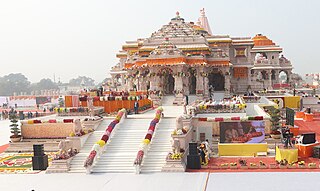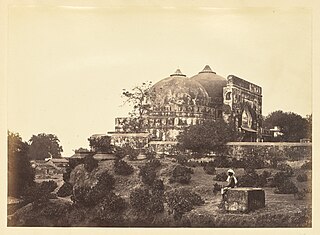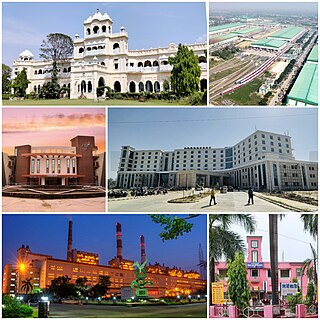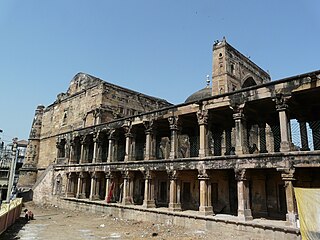
Ayodhya is a city situated on the banks of the Sarayu river in the Indian state of Uttar Pradesh. It is the administrative headquarters of the Ayodhya district as well as the Ayodhya division of Uttar Pradesh, India. Ayodhya became the top tourist destination of Uttar Pradesh with 110 million visitors in the first half of 2024, surpassing Varanasi.

Babri Masjid was a mosque in Ayodhya, India. It has been claimed to have been built upon the site of Ram Janmabhoomi, the legendary birthplace of Rama, a principal deity of Hinduism. It has been a focus of dispute between the Hindu and Muslim communities since the 19th century. According to the mosque's inscriptions, it was built in 1528–29 by Mir Baqi, a commander of the Mughal emperor Babur. Before the 1940s, the masjid was officially known as "Masjid-i-Janmasthan". The mosque was attacked and demolished by a Hindu nationalist mob in 1992, which ignited communal violence across the Indian subcontinent.

Uttar Pradesh is a state in northern India. With over 241 million inhabitants, it is the most populated state in India as well as the most populous country subdivision in the world – more populous than all but four other countries outside of India – and accounting for 16.5 percent of the population of India or around 3 percent of the total world population. The state is bordered by Rajasthan to the west, Haryana, Himachal Pradesh and Delhi to the northwest, Uttarakhand and Nepal to the north, Bihar to the east, Madhya Pradesh, Chhattisgarh and Jharkhand to the south. It is the fourth-largest Indian state by area covering 243,286 km2 (93,933 sq mi), accounting for 7.3 percent of the total area of India. Lucknow serves as the state capital, with Prayagraj being the judicial capital. It is divided into 18 divisions and 75 districts.

Meerut is a city in the western region of the Indian state of Uttar Pradesh. Located in the Meerut district, the city is 80 km (80,000 m) northeast of the national capital New Delhi, and is 480 km (300 mi) west of the state capital, Lucknow. Meerut is the second-most populous city in the National Capital Region (NCR), a region centered on Delhi. As of 2024, Meerut is the 34th most populous city in India.
Ram Janmabhoomi is the site that, according to Hindu religious beliefs, is the birthplace of Rama, the seventh avatar of the Hindu deity Vishnu. The Ramayana states that the location of Rama's birthplace is on the banks of the Sarayu river in a city called "Ayodhya". Modern-day Ayodhya is in the north Indian state of Uttar Pradesh. It is contested whether the Ayodhya mentioned in the Ramayana is the same as the modern city.

Jaunpur is a city and a municipal board in Jaunpur district in the Indian state of Uttar Pradesh. It is located 228 km southeast of state capital Lucknow. Demographically, Jaunpur resembles the rest of the Purvanchal area in which it is located.

Raebareli is a city in Indian state of Uttar Pradesh. It is the administrative headquarters of Raebareli district and a part of Lucknow Division. The city is situated on the banks of the Sai river, 82 km (51 mi) southeast of Lucknow. It possesses many architectural features and sites, chief of which is a strong and spacious fort. As of 2011, Raebareli had a population of 191,316 people, in 35,197 households.

Jaunpur district is a district in the Varanasi Division of the Indian state of Uttar Pradesh. The district headquarters is the city of Jaunpur which is situated on the banks of the Gomti River. It is located 228 km southeast of the state capital Lucknow. 65 km northwest of Varanasi and 732 km southeast of New Delhi. The district has two Lok Sabha seats and nine Vidhan Sabha seats. According to the 2011 census, Jaunpur has a gender ratio of 1,018 females to 1,000 males, the highest in Uttar Pradesh. The most commonly spoken language in the district is Hindi.

The Ayodhya dispute is a political, historical, and socio-religious debate in India, centred on a plot of land in the city of Ayodhya, Uttar Pradesh. The issues revolve around the control of a site regarded since at least the 18th century among many Hindus to be the birthplace of their deity Rama, the history and location of the Babri Masjid mosque at the site, and whether a previous Hindu temple was demolished or modified to create the mosque.

Prayagraj, formerly Allahabad is a metropolis in the Indian state of Uttar Pradesh. It is the administrative headquarters of the Prayagraj district, the most populous district in the state and 13th most populous district in India and the Prayagraj division. The city is the judicial capital of Uttar Pradesh with the Allahabad High Court being the highest judicial body in the state. As of 2011, Prayagraj is the seventh most populous city in the state, thirteenth in Northern India and thirty-sixth in India, with an estimated population of 1.53 million in the city. In 2011, it was ranked the world's 40th fastest-growing city. The city, in 2016, was also ranked the third most liveable urban agglomeration in the state and sixteenth in the country. Hindi is the most widely spoken language in the city.
Ganga Expressway is an under-construction, 1,047 km (651 mi) long, of which 594 km (369 mi) has been approved, 6-lane wide greenfield expressway in the state of Uttar Pradesh, India. It is being constructed in two phases. Phase-1 will connect Bijauli village on NH-334 in Meerut district with Judapur Dandu village on NH-19 in Prayagraj district via Sarai Katiyan village on NH-27 in Kanpur, while Phase-2 will see the extension of both sides of the expressway: from Prayagraj to Ballia and from Meerut to Haridwar.

The Jama Mosque is a 17th-century congregational mosque located in the historic core of Agra, Uttar Pradesh. It was built by Jahanara Begum, the eldest daughter of Mughal Emperor Shah Jahan, during the latter's reign. It is the principal mosque in the city of Agra, and lies close to Agra Fort.

The demolition of the Babri Masjid was carried out on 6 December 1992 by a large group of activists of the Vishva Hindu Parishad and allied organisations. The 16th-century Babri Masjid in the city of Ayodhya, in Uttar Pradesh, India, had been the subject of a lengthy socio-political dispute, and was targeted after a political rally organised by Hindu nationalist organisations turned violent.
Ram Janmabhoomi Nyas is an organisation which was formed as a trust to promote and oversee the construction of a temple in Ayodhya, India at the Ram Janmabhoomi, the reputed site of the birth of the Hindu deity Rama. The Nyas was formed by members of the Vishva Hindu Parishad.

Fatehpur District is one of the 75 districts of the Indian state of Uttar Pradesh. The district has a population of 2,632,733. Fatehpur city is its administrative headquarters.

The Jama Masjid Shamsi also known as Jama Shamsi Shahi is a mosque a major mosque built in the historic center of Budaun, Uttar Pradesh, India.

The 2019 Prayagraj Ardh Kumbh Mela was the Ardh Kumbh Mela held at Triveni Sangam in Prayagraj, Uttar Pradesh, India from 15 January to 4 March 2019. This event will be followed by the Prayag Maha Kumbh scheduled for January to February 2025.

The Ram Mandir is a partially constructed Hindu temple complex in Ayodhya, Uttar Pradesh, India. Many Hindus believe that it is located at the site of Ram Janmabhoomi, the mythical birthplace of Rama, a principal deity of Hinduism. The temple was inaugurated on 22 January 2024 after a prana pratishtha (consecration) ceremony. On the first day of its opening, following the consecration, the temple received a rush of over half a million visitors, and after a month, the number of daily visitors was reported to be between 100,000 and 150,000.
Dhannipur is a village in Ayodhya district of Uttar Pradesh, India. In February 2020, the government allotted 5 acres (2.0 ha) of agricultural land at Dhannipur in Ayodhya municipal corporation to the Uttar Pradesh Sunni Central Waqf Board as an alternative site for constructing a mosque, to replace the Babri Masjid that was demolished in 1992. The Babri Masjid, after being re-built is now known as the Mohammed Bin Abdullah Masjid.

On 24 November 2024, violence erupted during a court-ordered Archaeological Survey of India (ASI) survey of the Shahi Jama Masjid, a 500-year old mosque in Sambhal, protected by ASI, in the Indian state of Uttar Pradesh. The survey was initiated following claims that the mosque was constructed on the ruins of a Hindu temple allegedly demolished during the Mughal period. While the first survey had proceeded peacefully, tension escalated during the second survey when the wuzu khana used before prayer in the mosque, had been drained, allegedly to check the depth, leading to rumours of the mosque being dug up. The President of the Masjid committee tried to convince people that the mosque was not being broken. While some were reassured and left, others remained enraged.
















